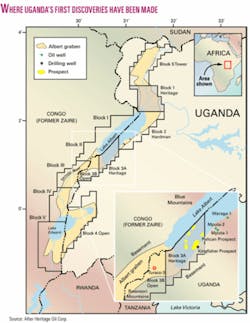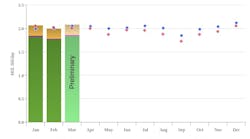Discoveries near Lake Albert in landlocked Uganda are awakening exploration interest all along the Albert graben.
However, it might be a considerable time before crude oil begins flowing from this remote area of Central Africa. It could take one to three years before commerciality could be determined.
It is a good 700 miles from the Albert graben to the Indian Ocean coast at Mombasa, Kenya. It would take certification of 300-500 million bbl of recoverable oil to support construction of a pipeline. Smaller reserves might support construction of Uganda’s first refinery.
Even modest discoveries could be economic because the local costs of refined petroleum products is very high, particularly in western Uganda (OGJ, June 10, 2002, p. 42).
On the exploration side, four blocks are in force in Uganda starting near the border with Sudan. Operators have applied for blocks on the Congo (former Zaire) side of the graben, and awards could be forthcoming soon, one source said.
Drilling operations
Discoveries at Waraga and Mputa have put Uganda on the world exploration map in recent months.
Heritage Oil Corp., Calgary, spudded its Kingfisher-1 vertical well in mid-August in Block 3A on the Lake Albert shore (see map). The well targets a large structural high expressed at surface on the lake bed and defined by two 2D seismic surveys. It targets multiple pay zones to 4,000 m.
The prospect, which extends under the lake, could contain 1.3 billion bbl of oil in place (OGJ Online, July 5, 2006).
Block 3A interests are Heritage and Tullow Oil PLC, London, 50% each.
Oil exploration
Independent operators were testing two discoveries 19 km apart on two blocks.
Hardman Resources Ltd., Perth, gauged the Waraga discovery in July 2006 on Block 2, which it holds 50-50 with Tullow Oil.
It flowed 8,400 b/d of 33.8° gravity oil and 3,650 b/d of 18.6° gravity oil from a total of three zones. TD is 2,010 m in basement.
Hardman-Tullow’s Mputa-1, meanwhile, drillstem tested 300 b/d of 32° gravity oil from a lower sand zone at 1,118-26 m and 820 b/d of 33° gravity oil from an upper sand zone at 966-974.5 m.
The gravity of all oil flowed at Mputa is similar to that found in Waraga’s lower units and is likely to be of similar origin, Hardman said.
Mputa is 8 km from the lake shore and 220 km northwest of Kampala, Hardman said.
“Collectively the results to date indicate that oil from the source interval deep under the lake can migrate all the way across the rift valley to the boundary fault and thus potentially over the whole license, considerably upgrading remaining prospectivity,” Hardman said.
Meanwhile, Tower Resources PLC, London, was starting farmout work on 1.5 million acre Block 5 about 160 km north of the discoveries (OGJ Online, July 18, 2006).
No seismic data are available on the block, which is an unexplored graben known as Rhino Camp near the northern end of the Albert graben.
It is highly probable that reservoir, structure, and seal are present at Rhino Camp, and there are indications from gravity data to support structural presence. The main exploration risk is considered to be the thermal maturity of source rocks, Tower Oil said.
Further geophysical interpretation is being undertaken and new geophysical activity is planned to determine how deep the basin is and, therefore, how analogous Block 5 may be to Block 2.
Block 5 has an initial exploration period of 2 years with a $700,000 minimum expenditure. The initial work commitment is 200 km of seismic within 2 years in order to identify areas of structural or stratigraphic interest for further investigation.


